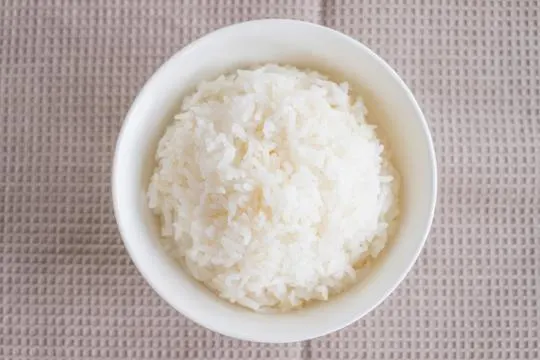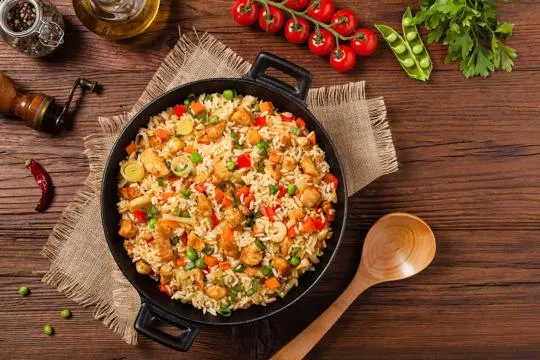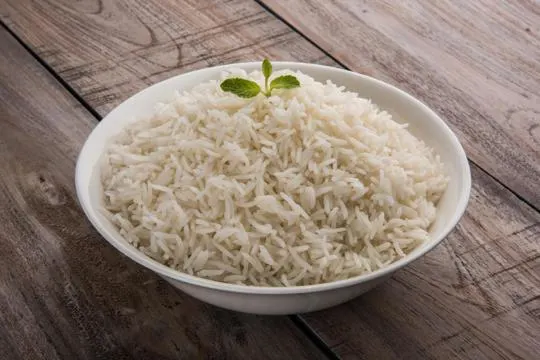Rice is a staple food for almost half the planet. We all munch on it.
It comes in two styles that stir up kitchen debates: steamed and fried.
Steamed rice, our fluffy friend, lands on plates looking innocent.
There’s an art to getting it just right. Fried rice, though?
It’s the wild cousin, jazzed up with veggies, eggs, or whatever leftovers found in the fridge.
Confession time; we’ve all had midnight fried rice raids. It’s a mix of craft and magic.
Each has its champions. Which side are we on?
Keep reading. We’re about to dive deep.
What is Steamed Rice?

Steamed rice is a staple food in many cultures and cuisines around the world.
It is a versatile ingredient that can be paired with a myriad of dishes to create a satisfying and filling meal.
Made by boiling rice grains in water until all the water is absorbed, the grains are then left to sit and simmer in their own steam.
This process not only ensures that the rice is cooked evenly, but also retains its natural flavor, texture, and nutrients.
The high water content in steamed rice makes it a great source of hydration, while its low-fat content makes it a healthy option for those watching their weight.
So whether you enjoy it as a side dish or the base of a savory bowl, steamed rice is a delicious and nutritious option that will leave you feeling satisfied and content.
What is Fried Rice?

Fried rice is a beloved Asian dish.
Pre-cooked, cooled rice is fried with various ingredients.
It is easy to make and can be customized with veggies, meats, seafood and sauces.
High heat adds a smoky flavor.
Serve it as a main course or with other dishes.
It is simple, versatile and a great way to use up leftover rice.
Eggs, scallions, carrots, peas, corn and proteins like chicken or shrimp enhance flavors and textures.
Soy sauce or oyster sauce adds a savory umami taste.
Optional additions include garlic, ginger, sesame oil or chili paste.
Many colors and flavors make every bite exciting.
Fried rice is practical, too.
It uses up leftover rice and minimizes food waste while maximizing flavor.
International acclaim comes from its ability to transform simple ingredients into a captivating dish.
Personalize it according to your preferences – satisfaction is guaranteed even with limited resources.
Preparation Methods: Steamed Rice vs Fried Rice
Steamed rice and fried rice are two popular dishes, but with distinct preparation methods.
Steamed rice is cooked by boiling it in water until soft, while fried rice involves stir-frying pre-cooked rice with ingredients.
The first difference lies in the cooking process; steaming is simple, while stir-frying brings out flavor.
In terms of texture, steamed rice is light and fluffy, and works as a side.
Fried rice is slightly chewy, creating a combo of soft and crunchy.
Taste-wise, steamed rice is neutral and complements other flavors.
Fried rice has a bolder taste due to its ingredients.
It’s clear that steamed rice and fried rice have major differences.
Both offer a delicious way to enjoy the staple.
Differences Between Steamed Rice and Fried Rice

Steam rice and fried rice vary significantly in taste, texture, cooking methods, and nutrition.
Steamed rice provides a plain, neutral base for meals, while fried rice stands out with its flavorful blend of spices and ingredients.
It all comes down to personal preference and dietary considerations.
So, whether you’re in the mood for a simple side dish or a vibrant main course, steamed and fried rice both have something special to offer.
Texture and Appearance
Steamed rice and fried rice vary significantly in texture and look.
Steamed rice has a light, tender texture, with grains that are distinct.
It’s plain white in color, giving off a clean vibe.
Fried rice, on the other hand, has a stickier texture due to its cooking method.
The grains are coated in flavorful oils, making it clumpy.
Furthermore, it’s vibrant and colorful, often featuring ingredients like veggies, meats, and eggs.
Steamed rice appears lighter and less oily compared to fried rice.
This is because steamed rice is cooked by boiling or steaming it in water, while fried rice involves frying the cooked rice with various ingredients in oil or butter.
The frying process adds flavor but makes it heavier.
When it comes to serving, steamed rice is usually served as a side dish or a base for other dishes.
It complements the flavors of the main dish.
Fried rice, however, is often served as a standalone dish or part of a meal.
Its bold colors and flavors make it delectable.
In conclusion, steamed and fried rice provide different textures and appearances for different dining experiences.
Steamed rice is an ideal accompaniment, while fried rice is an indulgent solo treat.
Choosing between the two depends on your taste.
Flavor Profile
Steamed rice has a plain taste, while fried rice is full of flavor.
The cooking of it allows it to take in the seasonings, veggies, and proteins added.
This makes it savory and aromatic.
Steamed rice has a subtle taste, and it’s great to pair with many dishes.
Fried rice, on the other hand, is bold and complex.
Soy sauce, garlic, ginger, carrots, peas, shrimp, and chicken all bring their own unique tastes, creating a symphony for your tastebuds.
Fried rice gets even better when cooked; the grains come together and form clumps.
This lets the flavors mingle and make every bite even more delicious.
Plus, the texture change gives you a different eating experience.
Cooking Techniques
Cooking techniques vary, each bringing its own unique flavors and textures.
Steaming is a common one.
It’s done by using moist heat to cook food, often vegetables, seafood, and rice.
Put them in a steamer or above boiling water, and the steam cooks them.
This method preserves their natural flavors and nutrients, since it doesn’t use oil or fat.
Frying is different.
It involves cooking in hot oil or fat.
This gives the food a crispy outside and moist inside.
Fried rice, for instance, is made by stir-frying cooked rice with veggies, protein, and seasonings in a wok or pan.
The high heat cooks them quickly and infuses them with the flavor of the oil or fat.
Steamed and fried rice differ in taste and texture.
Steamed rice is light and fluffy, with individual grains that separate easily.
It has a subtle flavor.
Fried rice has a more robust flavor, due to the seasonings added while frying.
It also has a slightly chewy texture.
Ingredients and Seasonings
Ingredients and seasonings are key factors for distinguishing steamed rice from fried rice.
Both dishes offer unique flavors, crafted by carefully selecting and combining ingredients.
Steamed rice is simple – usually just water, salt, and rice.
While fried rice has more freedom – vegetables like carrots, peas, onions, and bell peppers, proteins like chicken, shrimp, or tofu, plus sauces like soy or oyster sauce.
To make the difference clear, understanding seasoning is a must.
For steamed rice, salt is enough to bring out its flavor.
But, fried rice needs a selection of seasonings, like garlic powder, ginger powder, and pepper, to make its taste profile pop.
Similarities Between Steamed Rice and Fried Rice

Steamed rice and fried rice may appear distinct in taste and presentation, but they also share some similarities.
- They both start with the same basic ingredient – rice. This means the cooking process starts with boiling or steaming the grains.
- Texture-wise, they’re both fluffy and tender. This is because both dishes need properly cooked grains – not under or overcooked. The ideal consistency is essential for a great dish.
- Both are versatile. Steamed rice and fried rice can serve as a base for various ingredients, like veggies, meat, seafood, or tofu. This offers endless flavor combinations and creative possibilities.
- Enjoy them on their own or as an accompaniment. They provide a neutral and satisfying base that complements flavors without overpowering them. Whether with stir-fries or curries, they’re a reliable side dish option.
- Health-conscious individuals can take comfort in knowing both are healthier when prepared with minimal oil. Steaming or stir-frying helps retain more nutrients than deep-frying.
Variations and Regional Differences
Variations and regional differences make steamed and fried rice unique.
These arise from culinary traditions that have evolved around the world.
Chinese fried rice is made by stir-frying pre-cooked rice with ingredients like vegetables, meat and eggs.
Flavors are enhanced with soy sauce, ginger, garlic and seasonings.
This technique gives each grain of rice its own flavor.
Steamed rice is a staple in many Asian countries.
It’s cooked in water or stock until all the liquid is absorbed, giving it a fluffy and sticky texture.
This serves as a base for other dishes to show their flavors.
Regional variations further contribute to the diversity.
For example, Thai fried rice has a distinct flavor with fish sauce, shrimp paste and Thai basil.
Indian steamed rice comes in different versions such as biryani and pulao, which are cooked with spices like saffron, cardamom and cinnamon.
Popular Dishes and Cuisines
Popular Dishes and Cuisines are a treasure of flavors that enthrall our taste buds.
Every country has its own signature dish – from Italy’s pizza to India’s biryani.
These dishes reflect not only the culinary traditions, but also a country’s cultural heritage.
Exploring these dishes allows us to take a global gastronomic adventure.
Indulging in popular dishes and cuisines is like voyaging continents through our taste buds.
Italian cuisine delights us with its combination of simple ingredients, creating flavorful wonders.
From traditional rustic pasta dishes to savoury pizzas with scrumptious toppings – Italian cuisine satisfies our hunger and craving for deliciousness.
Indian cuisine, on the other hand, lures us with its aromatic spices, vivid colors, and assorted flavors.
Whether it be the fiery curries of North India or the aromatic biryanis of Hyderabad – every dish narrates a tale of the rich culinary heritage.
When exploring popular dishes and cuisines, it is important to note the unique features that set them apart.
For example, Thai cuisine tantalizes with its blend of sweet, sour, salty and spicy flavors – like Pad Thai or Green Curry.
Japanese cuisine is all about elegance and accuracy – in items such as sushi or sashimi, where the freshness of ingredients takes center stage.
And Mexican cuisine offers a fiesta of flavors with its hearty tacos and colorful salsas.
Conclusion
After researching the science behind the process of steamed and fried rice, it is clear that they are both tasty accompaniments to any meal.
Both versions of rice offer a unique flavor and texture, giving cooks multiple options for adding personality to an otherwise plain dish.
While fried rice offers a crunchy edge and stronger taste, steamed rice provides a tender softness and more delicate flavor while absorbing seasonings better.
Whether choosing one over the other (or using them both.
) depends entirely on personal preference and comfort level with cooking.
With an understanding of these variations in taste, texture, cooking preparation time, and nutritional impact between steamed and fried rice, you can now confidently make the decision when serving up delicious dishes for your dinner guests or family.

Leave a comment